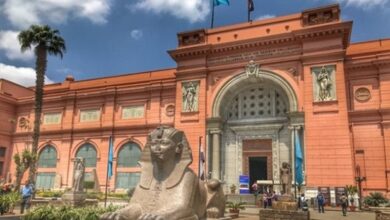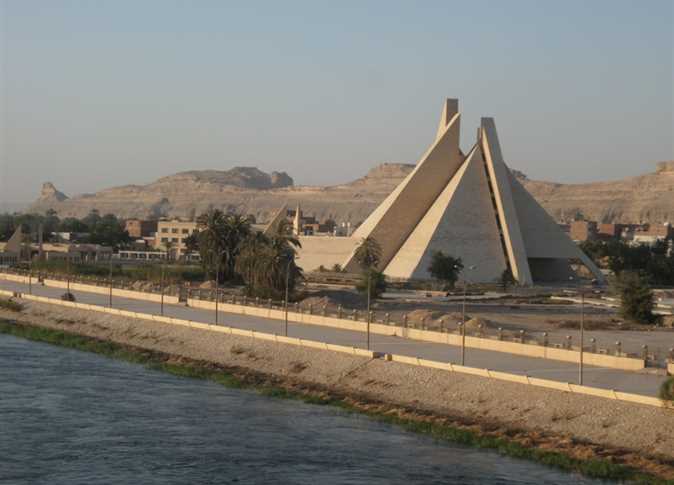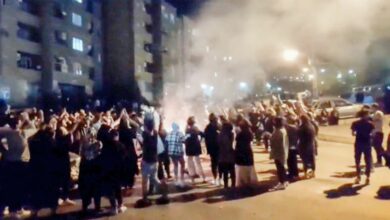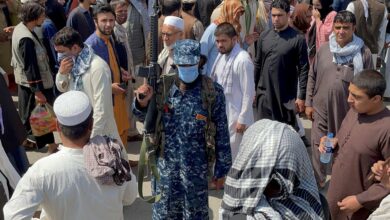
Since October when the army forcibly dispersed a peaceful protest at Maspero, claiming the lives of 27 mostly Coptic protesters, it has become customary for the ruling Supreme Council of the Armed Forces (SCAF) to hold a press conference after a bloody attack on protesters with two LCD monitors on each side of the podium.
The screens are there to complement the text read by whichever general has been chosen to address the media on behalf of the SCAF and the Egyptian military. This time, following five days of clashes between the army and protesters on Qasr al-Aini Street, it was SCAF member Major General Adel Emara who took the lead in addressing the media in a presser. The violence was preceded by a sit-in lasting around three weeks in front of the cabinet building on Qasr al-Aini, with protesters objecting to military rule and the appointment of Kamal al-Ganzouri as prime minister. Ganzouri also held this post during the 1990s under toppled President Hosni Mubarak and is considered to be a remnant of the former regime.
Like at the Maspero presser, held on 12 October, Emara denied that the armed forces used excessive violence against the protesters, saying, "The military is not trained to use such violence." But, Emara explained, any force that was used by the military was in reaction to the protesters' intentional and systematic provocation. “No human can bear what the protesters subject us to,” he said. The military thus quelled the destructive drive of the hidden hand plotting to topple the state with the least possible amount of violence. “We are envied for our level of self-restraint,” Emara added.
In the speech, the protesters were characterized as thugs, infiltrators or agents paid for by a mysterious force that seeks to destroy Egypt. The general’s warnings were framed as coming from an ordinary Egyptian citizen who is concerned for Egypt and the "prestigeof the state"rather than a member of the ruling military council.
The video shown by Emara was meant to support the SCAF's narrative: to prove that it was the demonstrators who were on the offensive, trying to break into the parliament building and set aflame the Egyptian Scientific Institute, allegedly for no reason other than to wreck havoc and tarnish the image of the army, as dictated by the invisible hand.
The video consisted of an incoherent sequences of shots (mixed angles, day and night shots, indoor and outdoor shots), heavily edited and mostly irrelevant. The shots are not meant to be logical or coherent. They are meant to play on irrational fears of chaos, conspiracies, mob behavior and even sexual license and debauchery. The video tries its best to depict those who were beaten and detained by the military as ignorant, unprincipled, gullible and poor. The video featured “confessions” of detained minors who were compelled to name well-known activists as being behind the clashes.
Emara introduced the video with the words: "These shots are neither prepared beforehand nor fabricated. They are being circulated in the media. It's about facts; you see what happened with the eye you wish to see it with. These are facts that I am putting in front of you.” He paused to ask that the volume be turned up then continued, “Of course the beginning of the event is visible here. Our soldiers are inside the parliament building and the tents are outside. No friction whatsoever between the two groups.”
The first shot has a title over the moving image that reads, "The infiltrators among the revolutionaries.” The video is an excerpt from state television coverage. You see a group of boys and girls sitting on the sidewalk chatting and laughing and the camera moves to focus on a young couple; the man's arm rests on the girl's shoulders. There are no signs of a protest. In fact the sidewalk and street around them are quite clean and you hear no sounds of clashes, only the joyous babble of the youngsters. It is daytime in the shot. Before you realize it, the shot is cut short by footage that was taken from atop a building at night.
The shot of the couple could not have had any other function than to provoke disapproval of the mixing of the sexes at the sit-in and the permissive behavior allegedly taking place between male and female protesters. The rest of the video attempts to further stigmatize the “protesters” and to depict them as destructive and immoral.
The shots that follow show individuals — mostly young — throwing stones. The camera focuses on the aggressive act of hurling stones and avoids any context. We do not see the sequence of events, what happened before the throwing, who they're throwing at and why. At some point, we see the same shot that was used by the SCAF in their video statement number 90, this time in slow motion: a few people holding broken pieces of furniture, fighting something/someone in the window of a building. Emara had to explain the unclear image as "the protesters entering the parliament building." No mention is made of the existence of aggressors on the roof and inside the building. Our minds only perceive the unexplained urge of the protesters to vandalize the building.
Scenes of the burning Egyptian Scientific Institute and the Transportation Ministry building on Qasr al-Aini Street are shown at length. We see the flames coming out of the windows and a seemingly careless amused crowd, many of them young, throwing stones while smiling.Emara commented, "They are saying we will burn we will burn."
Emara spoke over scenes of the Egyptian Scientific Institute burning, saying gravely, “This is the catastrophe! The institute burning! The nation's conscience…the nation's conscience is burning! This institute for which they wept, they wept. The world's breath stopped…the world's breath stopped as the history of Egypt was burning, and the youngsters who were burning this institute were taking pride in such acts. The Egyptian Scientific Institute is completely destroyed. It dates back to 1798! It's over… in 2011.”
The following scene shows firefighters hosing water inside one of the institute's windows although the fire seems to be out by the time this scene was shot. Emara explained: "Of course all the firefighters' attempts, be they civilian or military, to reach the fire earlier were prevented."
The next shot was clearly taken earlier, when the firefighters would have been useful. It shows flames pouring out of a window of the institute. According to Emara, this is "a picture that will be registered by the world. A shame for us, that this institute should burn. The secretary general of the institute called me crying. It had some manuscripts and books inside that were the history of Egypt.”
Afterward, in a night shot, a man talks to the camera; "Nobody here is 'clean', they're all thieves and thugs.’” The camera man asks innocently, “Really? All of them?” The interviewee answers affirmatively.
To reinforce hatred for the mad, destructive, irrational protesters, the next shot shows a soldier holding a bandage on his face and bleeding, with two sympathetic soldiers on each side of him, then a soldier lying on a stretcher, visibly in pain. Fellow soldiers and an army officer take him to the ambulance van. In the following scene, he is being treated by doctors. At this point, Emara interjected: “Stop there. Stop, go back (the video is rewound). This is a picture of an injured soldier, because you talk of excessive use of force and such things. This is a soldier whose legs are completely torn from a sharp tool that the protesters, well, one of the protesters had.” A cut is visible on the side of the soldier’s thigh. “He hit the soldier with it and cut his artery, and he is now in a critical condition.” Emara then asked that the screening go on.
The next scene depicts peaceful, hardworking soldiers building a barbwire barrier. When this was shown, Emara confirmed that "this is the stage when we started to build barriers." In the following shot, demonstrators at a different time of the day throwing rocks at a metal fence. The camera is filming from inside the fence, which was built on the third day of the clashes on Qasr al-Aini Street. Emara explained: "Again, this is an attempt to thwart our effort to build the insulating wall." The next scene shows a much larger crowd of protesters. This time the camera is filming behind the “insulation” wall, built by the army on the third day of clashes. Some protesters are holding flares that, according to Emara, "are flares that are usually used in football matches. They are using them to hit the soldiers." The next shot shows soldiers looking at a flare in a pond in front of them.
The second half of the video is made up of interviews with minors and one adult woman. Most of the minors interviewed are detained in a location that seems to be the parliament building. They look scared, and their testimonies are vague and hesitant. Some of them are injured. One has a stream of blood running from his forehead to his chin. While the woman is being interviewed with two microphones, one of which carries the logo of state TV, screams can be heard in the background, likely coming from someone who is being tortured.
Four minors are questioned about the people who supposedly pushed them to participate in the clashes. One of the minors seems less frightened and does not appear to be injured. The interviewer asks him: “Did you see anything strange in the square or in your neighborhood or anywhere?”
The child: “Yes, I noticed that in our building there is a publishing house called Dar Merit. During the beating and the “Mohamed Mahmoud” clashes and such things, the publishing house was distributing helmets and tear gas remedies and masks to people.”
Interviewer: “Where is it?”
The child: “In our building on 6 Qasr al-Nil Street.”
The person conducting the interview asks who the owner of the publishing house is, and the child answers that his name is Mohamed Hashem. The interviewer says, “Mohamed Hashem. Ok. What else did you see?”
The child: “I saw that during sit-ins they used to bring food and bread and such things and distribute them to people.”
The interviewer clarifies that the child saw this in Tahrir Square, and the boy answers in the affirmative, adding, “Whenever anything happened they would gather, divide into groups and enter the square from different points.”
The interviewer asks the child if he saw what these people were doing in the square, and the child answers: “For instance, if you're not wearing a helmet they give you one and tell you… they incite you… they tell you go in and such things. For instance they say, 'You let your brothers get beaten there?' It happened in front of me.”
Interviewer: “It happened in front of you? They didn't try to bring people from outside or give them money? You haven't seen any of them giving money to anyone?”
The child: “No, no money… but I noticed that all of them let their beard grow from here [he holds his hand to his chin], but not too long. They cut it if it gets too long. And they have braided hair.” The interviewer asks the boy if they all look alike and he says yes. When the interviewer asks how many of these people the boy saw in the square, he says, “About 120.” The interviewer clarifies the number then asks if there are both men and women and if they work in the publishing house. The child answers both questions affirmatively.
“They work in the publishing house, but during the fighting you don't see them in the front lines. They are not the ones who are fighting,” the boy says.
The boy explains that he observed all of this from his building, which overlooks the square, and the interviewer thanks him for his testimony.
The video moves on to show a state TV interview of a tired looking woman wearing a pink scarf. Her answers drift into a personal account of family problems: sexual harassment by her in-laws, her precarious marital arrangement, a drug-trafficking step-father, poverty and domestic violence.
At this point Emara shouted: “Fast forward we're running out of time.” But several journalists objected, saying “We want to hear.” Emara gave in to their demands, allowing the woman’s peculiar statement to continue airing.
The woman continues to speak in a whisper, saying that she had been detained for throwing stones but maintaining her innocence, then moving on to a long-winded story about her family’s legal troubles.
Finally the general became impatient with the woman’s disjointed testimony, exclaiming: “Let's move to something else. Move to the next!”
One of the other minors interviewed has a faint voice and seems to be on the verge of crying. He says: “I don't know who the man was; I've got nothing to do with it. I've got nothing to do with politics… so I made him a Molotov cocktail. I entered the tent of the Ultras, I found flares and molotovs.”
Interviewer: “But Mostafa you made this Molotov cocktail, where did you get it from?”
After some stuttering, Mostafa answers that someone named Mr. Meguid gave him LE50 to purchase benzene to make a Molotov cocktail. The interviewer asks how the child made Molotov cocktails, and Mostafa explains, “I fill the bottle with benzene. I put cloth in it and throw it.” The child then clarifies that he does not actually throw the Molotov cocktails, saying he doesn’t know how. He is only responsible for making them.
The interviewer asks if the child sleeps in the street and who provides for him, and Mostafa answers that Mr. Meguid gives him, and other street children, food and drink. The interviewer asks, “How much did he give you daily? LE100?” Mostafa nods.
The film closes with a shot of a calm night street. At this point, Emara closed the conference with the dramatic statement: “Egypt has not and will never fall”
For many, the video doesn't clarify what happened at the cabinet sit-in. But it may be successful in provoking hatred against the protesters. As fears of moral decadence, chaos and vicious plots rises, the public may come to believe that an excess of violence and a bit of killing may be necessary to save Egypt from impending danger.




